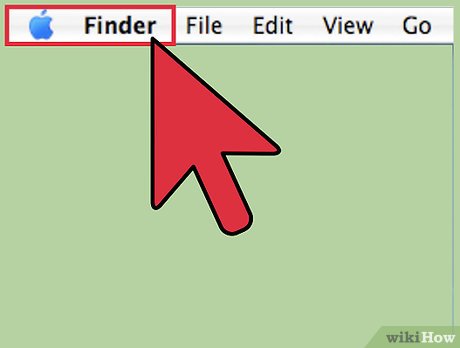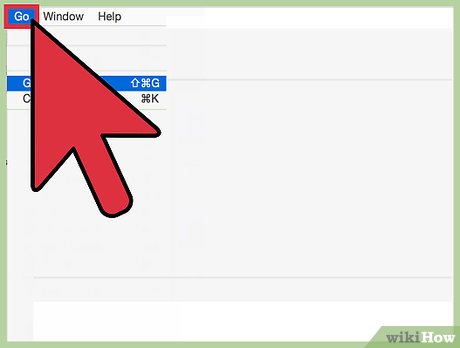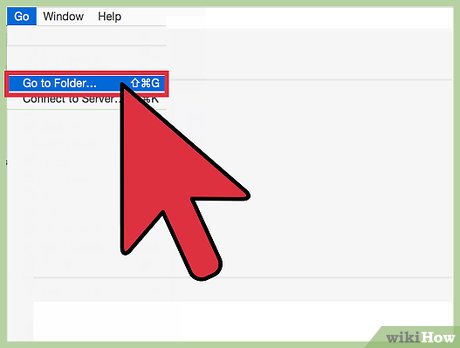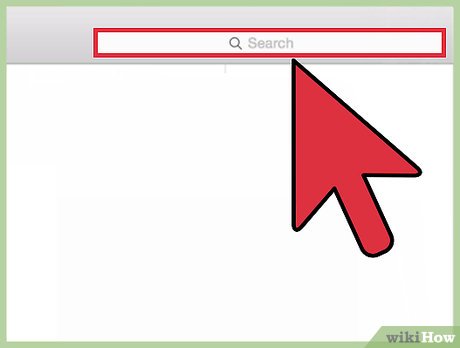How to Rid Your Computer of Temporary Files
Method 1 of 4:
Deleting Temporary Cache Files (Mac)
-
 Click the "Finder" icon to open the Finder. Mac's search app, the Finder, resembles a blue face.
Click the "Finder" icon to open the Finder. Mac's search app, the Finder, resembles a blue face. -
 Click the "Go" tap at the top of your screen. This should be to the right of the "Edit" tab.
Click the "Go" tap at the top of your screen. This should be to the right of the "Edit" tab. -
 Click "Go to Folder". This should be toward the bottom of the "Go" menu. Doing so will prompt you to enter a destination.
Click "Go to Folder". This should be toward the bottom of the "Go" menu. Doing so will prompt you to enter a destination. -
 Type "~/Library/Caches" into the text field. Exclude the quotation marks. The "Caches" folder is where your Mac's temporary files are stored.[1]
Type "~/Library/Caches" into the text field. Exclude the quotation marks. The "Caches" folder is where your Mac's temporary files are stored.[1]- Click "Go" when you're finished.
- If you want to clear all temporary files on your Mac, you should also delete the contents of "~/Library/Logs" when you finish deleting the Cache folder contents.
-
 Review the contents of the Cache folder. Since everything here is a temporary copy, you can delete these files without repercussions.
Review the contents of the Cache folder. Since everything here is a temporary copy, you can delete these files without repercussions. -
 Select a folder, then hold ⌘ Command and tap A. This will select your Cache folder's contents.
Select a folder, then hold ⌘ Command and tap A. This will select your Cache folder's contents. -
 Hold Ctrl and click a file. This prompts a menu.
Hold Ctrl and click a file. This prompts a menu.- If your Mac's mouse has right-click functionality, just right-click (or two-finger click) the file.
-
 Click "Move to Trash". This will delete your Mac's temporary file cache!
Click "Move to Trash". This will delete your Mac's temporary file cache!
Method 2 of 4:
Deleting Temporary Safari Files (Mac)
-
 Open Safari. If you're experiencing refresh issues or webpage loading errors on Safari, you can clear the data cache without deleting your saved passwords, cookies, or history. You'll have to open Safari, which resembles a blue compass, to do so.
Open Safari. If you're experiencing refresh issues or webpage loading errors on Safari, you can clear the data cache without deleting your saved passwords, cookies, or history. You'll have to open Safari, which resembles a blue compass, to do so. -
 Click the "Safari" option in the top left corner of your screen. This will bring up the Safari menu.
Click the "Safari" option in the top left corner of your screen. This will bring up the Safari menu. -
 Click the "Empty Cache" option. Safari will prompt you to confirm your decision.[2]
Click the "Empty Cache" option. Safari will prompt you to confirm your decision.[2] -
 Click "Empty". This will confirm your decision and empty your Safari cache. You may have to restart Safari to notice a difference in browsing speed.
Click "Empty". This will confirm your decision and empty your Safari cache. You may have to restart Safari to notice a difference in browsing speed.
Method 3 of 4:
Deleting Temporary Files with Disk Cleanup (PC)
-
 Open your PC's "Run" app. You'll used Run to access the Disk Cleanup utility. Depending on your operating system version, there are a couple of ways to open Run:
Open your PC's "Run" app. You'll used Run to access the Disk Cleanup utility. Depending on your operating system version, there are a couple of ways to open Run:- Hold down the ⊞ Win key and tap R. This should work on all versions of Windows.
- For Windows 8 or 10, hold down the ⊞ Win key and tap X to open user task menu, then tap or click "Run" near the bottom of the menu.
-
 Type "cleanmgr" into the Run text field. Exclude the quotations. This command will start the Disk Cleanup program.
Type "cleanmgr" into the Run text field. Exclude the quotations. This command will start the Disk Cleanup program.- Click "OK" or tap ↵ Enter to run your command.
-
 Wait for Disk Cleanup to assess your temporary files. Depending on how long it has been since your last temporary file flush, this may take a few minutes.
Wait for Disk Cleanup to assess your temporary files. Depending on how long it has been since your last temporary file flush, this may take a few minutes. -
 Select your temporary files for deletion when prompted. Do this by clicking the check box next to each file type you wish to delete.[3]
Select your temporary files for deletion when prompted. Do this by clicking the check box next to each file type you wish to delete.[3]- As a general rule, you can clear every file type; however, leave the "Compress old files" option alone, since it can cause issues when trying to retrieve old files.
- You can also click the "Clean up system files" option, which will cause Disk Cleanup to reassess your temporary files while considering system files. This will usually free up significantly more space than clearing the default temporary files will.
-
 Click "Delete Files" when prompted. This will begin the temporary file flush.
Click "Delete Files" when prompted. This will begin the temporary file flush. -
 Wait for Disk Cleanup to finish deleting your temporary files. You may have to reboot your computer to see a change in performance.
Wait for Disk Cleanup to finish deleting your temporary files. You may have to reboot your computer to see a change in performance.
Method 4 of 4:
Deleting Temporary Files Manually (PC)
-
 Open your PC's "Run" app. You'll use Run to open the temporary files folder on your computer. You can open Run by opening the user task menu with ⊞ Win and X on Windows 8 and 10, or you can hold the ⊞ Win key and tap R.
Open your PC's "Run" app. You'll use Run to open the temporary files folder on your computer. You can open Run by opening the user task menu with ⊞ Win and X on Windows 8 and 10, or you can hold the ⊞ Win key and tap R. -
 Type "%temp%" into the Run text field. Exclude the quotations. This command will open the physical temporary files folder.[4]
Type "%temp%" into the Run text field. Exclude the quotations. This command will open the physical temporary files folder.[4]- Click OK or tap ↵ Enter to run this command.
-
 Review the %temp% folder contents. Since the files in here are temporary copies, you can delete all of them without worrying about losing information.
Review the %temp% folder contents. Since the files in here are temporary copies, you can delete all of them without worrying about losing information.- Keep in mind that you won't be able to delete any temp files currently in use. To counter this, save your work and close all programs before continuing.
-
 Select a file, then hold Ctrl and tap A. This will select the contents of your temporary folder.
Select a file, then hold Ctrl and tap A. This will select the contents of your temporary folder. -
 Tap the Delete button. This will delete your temporary folder's contents. Alternatively, you can right-click a file and click "Delete".
Tap the Delete button. This will delete your temporary folder's contents. Alternatively, you can right-click a file and click "Delete".- Windows may ask you for confirmation of your choice to delete these files. If so, click "Confirm" on the pop-up window.
4 ★ | 1 Vote
You should read it
- Steps to remove temporary files stored on Kaspersky
- How to Clear Temp Files in Windows 10
- How to Clear the Cache on a Mac
- What is Temporary File? How to delete temporary files on windows computers
- How to Delete Temporary Files and Delete Prefetch Files from Your Computer
- Free up space on Windows 10 by deleting temporary files
- How to Clear Windows 7 Cache
- How to Clear System Cache on PC or Mac
May be interested
- How to Locate Temporary Internet Files
 this wikihow teaches you how to view a list of your browser's temporary internet files (stored cache data), which are pieces of data that help quickly load frequently visited sites. you cannot view temporary internet files on a mobile item...
this wikihow teaches you how to view a list of your browser's temporary internet files (stored cache data), which are pieces of data that help quickly load frequently visited sites. you cannot view temporary internet files on a mobile item... - Should I upgrade RAM for Macbook Pro?
 every computer has two types of memory, hard drive and ram. you can think of these two parts as repositories with different functions. the hard drive stores files permanently, while ram (random access memory) only stores temporary files. these temporary files are used to launch programs, store temporary data, and keep background processes running smoothly. if your computer has been running slow or crashing lately, you've probably heard that upgrading ram will fix the problem. while this is the right solution for some situations, you need to think twice before upgrading the ram on your macbook pro. if you are pondering whether this is the right choice (or whether it is possible) then this is the article for you.
every computer has two types of memory, hard drive and ram. you can think of these two parts as repositories with different functions. the hard drive stores files permanently, while ram (random access memory) only stores temporary files. these temporary files are used to launch programs, store temporary data, and keep background processes running smoothly. if your computer has been running slow or crashing lately, you've probably heard that upgrading ram will fix the problem. while this is the right solution for some situations, you need to think twice before upgrading the ram on your macbook pro. if you are pondering whether this is the right choice (or whether it is possible) then this is the article for you. - Top 3 best computer cleaning software 2020
 top 3 best computer cleaning software 2020. with devices such as pcs or smart phones when using for a long time will occur slow, jerky condition. this phenomenon is caused by junk files (junk files), or temporary files (temporary files) store a lot
top 3 best computer cleaning software 2020. with devices such as pcs or smart phones when using for a long time will occur slow, jerky condition. this phenomenon is caused by junk files (junk files), or temporary files (temporary files) store a lot - Instructions for sharing temporary files on DoShare
 doshare supports you to share unlimited temporary files and automatically delete them after 24 hours. users do not need to download and register an account to use doshare.
doshare supports you to share unlimited temporary files and automatically delete them after 24 hours. users do not need to download and register an account to use doshare. - TEMPORARY TABLE temporary table in SQL
 temporary table, also known as temporary table, is a special form of table that is temporarily stored and handles intermediate results on sql
temporary table, also known as temporary table, is a special form of table that is temporarily stored and handles intermediate results on sql - Delete temporary Internet files with Group Policy Preferences
 one way to improve the protection of your workstations and networks is to delete temporary internet files.
one way to improve the protection of your workstations and networks is to delete temporary internet files. - Delete these temporary Windows folders to reclaim precious storage space
 windows creates temporary files in the background to keep things running smoothly. but over time, these hidden files silently accumulate in system folders, slowly taking up all the space you have.
windows creates temporary files in the background to keep things running smoothly. but over time, these hidden files silently accumulate in system folders, slowly taking up all the space you have. - How to copy files and files from your computer to iPhone / iPad easily
 how to copy files and files from your computer to iphoneipad easily. with the tips in the article below, we can copy files and files from the computer to iphone / ipad easily and turn them into temporary portable storage.
how to copy files and files from your computer to iphoneipad easily. with the tips in the article below, we can copy files and files from the computer to iphone / ipad easily and turn them into temporary portable storage. - How to Clear System Cache on PC or Mac
 this wikihow teaches you how to clear temporary files from a windows or macos computer. you can accomplish this in windows by deleting the files from the temp folder, and on macos by rebooting the computer. press . this opens the run...
this wikihow teaches you how to clear temporary files from a windows or macos computer. you can accomplish this in windows by deleting the files from the temp folder, and on macos by rebooting the computer. press . this opens the run... - Install frames and temporary images on Facebook
 with a temporary avatar feature on facebook, you no longer have to remember to change your avatar after holiday or anniversary instead, it will automatically do it for you.
with a temporary avatar feature on facebook, you no longer have to remember to change your avatar after holiday or anniversary instead, it will automatically do it for you.

































 How to Search All Files and Apps on an Android
How to Search All Files and Apps on an Android How to Delete Startup Entries
How to Delete Startup Entries How to Restore Deleted Files in OneDrive
How to Restore Deleted Files in OneDrive How to Fix Windows 8.1 Crashes
How to Fix Windows 8.1 Crashes How to Create a System Restore Point
How to Create a System Restore Point How to Allocate a Drive Letter
How to Allocate a Drive Letter